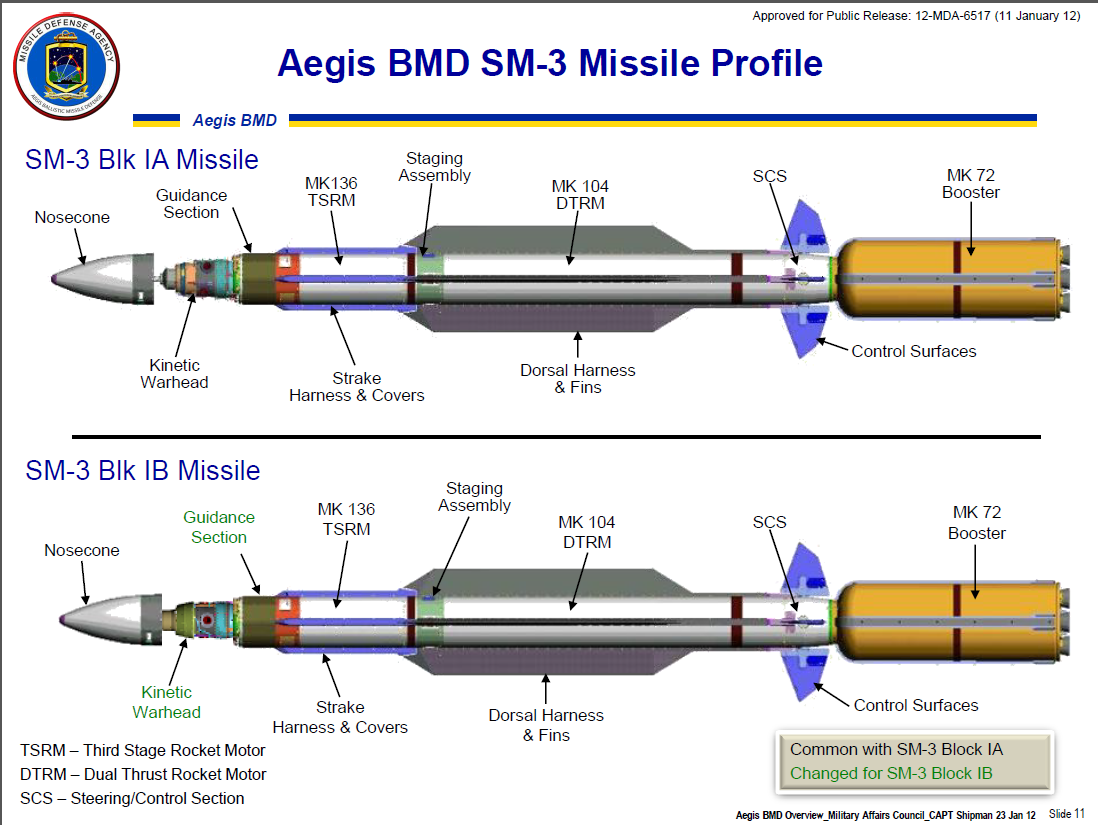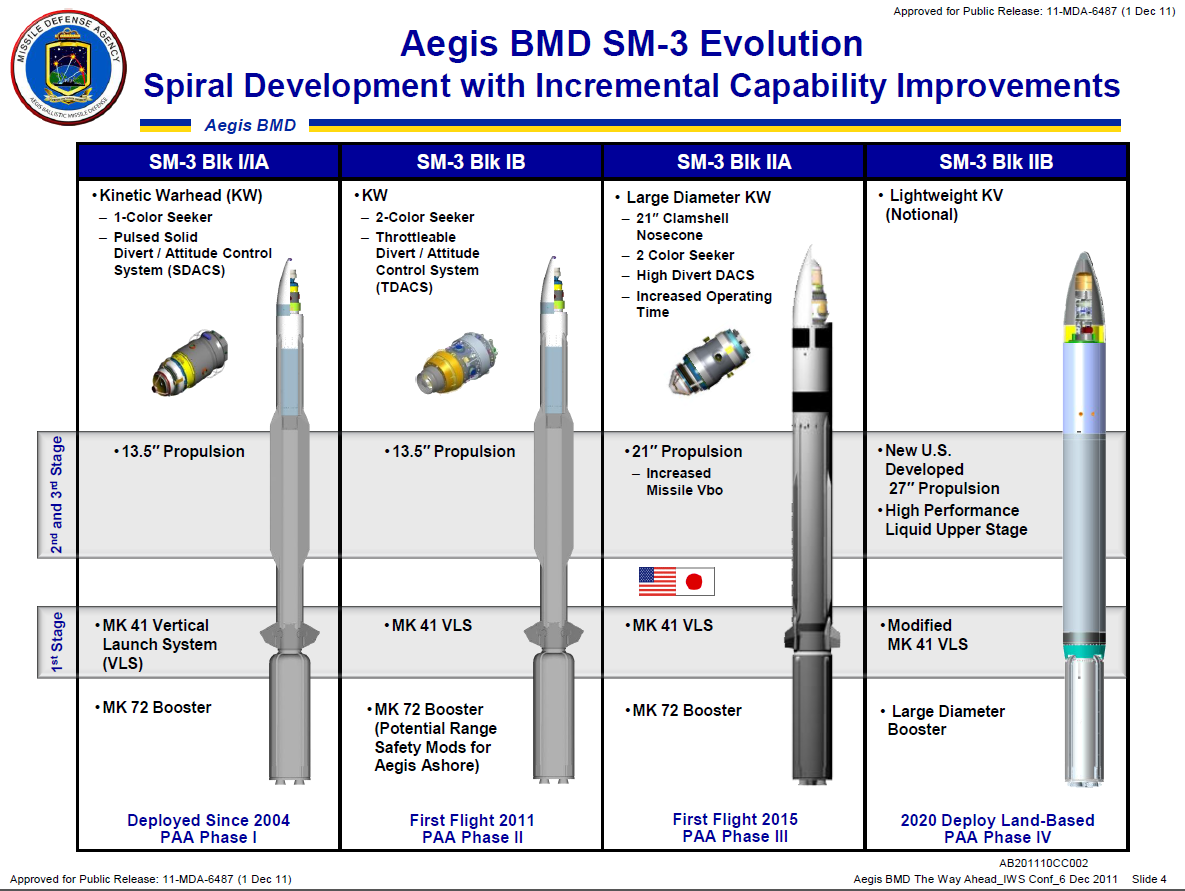Aegis Ballistic Missile Defence (BMD) System

 Aegis Ballistic Missile Defence (BMD) system was developed by the Missile Defence Agency (MDA) in cooperation with the US Navy. It is the sea-based element of the US BMDS.
Aegis Ballistic Missile Defence (BMD) system was developed by the Missile Defence Agency (MDA) in cooperation with the US Navy. It is the sea-based element of the US BMDS.
The Aegis BMD provides warships with the capability of intercepting and destroying short and medium-range ballistic missiles.

Variants of the Aegis system
The variations of the Aegis BMD system currently in service are the 3.6.1 version and the 4.0.1 version. The MDA and the US Navy plan to deploy more advanced versions, such as the 5.0, 5.1 and 5.2, in the future.
The improved versions will be equipped with advanced processors and software, as well as upgraded variants of the SM-3 interceptor missile.

Successful Aegis BMD system flight tests
Aegis BMD successfully completed the first intercept test in January 2002 and has to date achieved 23 successful intercepts from 28 attempts. The system demonstrated 20 successful exo-atmospheric intercepts in 25 attempts using the SM-3 missile.
These firings also included three successful intercepts in four attempts by the Aegis ships of the Japan Maritime Self Defence Force (JMSDF). The system also performed three successful endo-atmospheric intercepts in three attempts, using the SM-2 Block IV missile.
Standard Missile-3 and SM-2 Block IV interceptors
The Aegis BMD uses the Standard Missile-3 mid-course interceptors and the Standard Missile-2 Block IV (SM-2 Block IV) terminal-phase interceptors developed by Raytheon.
The SM-3 is capable of intercepting ballistic missiles above the atmosphere during the midcourse phase of a hostile ballistic missile's flight. The missile is launched from the MK 41 vertical launching system (VLS) of the warships. It receives in-flight target updates from the ship.
The kinetic warhead (KW) is designed to destroy a ballistic missile's warhead with more than 130 megajoules of kinetic energy. The existing SM-3 Block IA version will be upgraded to SM-3 Block IB, SM-3 Block IIA and SM-3 Block IIB to counter future ballistic missile threats.
The SM-2 Block IV can engage the ballistic missiles within the atmosphere in the terminal phase of a missile's trajectory. The missile carries a blast fragmentation warhead. The SM-2 Block IV will be replaced with a new extended range SM-6 interceptor.

Features of the US MDA's system
Aegis integrates Aegis combat system, SM-3 missiles and command, control and communication systems of the US Navy and joint forces.
The Aegis BMD configured ships can detect and track ballistic missiles of all ranges and transfer target detection information to the ground-based midcourse defence interceptors in Alaska and California.
The LRS&T capability shares tracking data to cue other components of the BMDS including PAC-3, terminal high altitude area defence (THAAD) and medium extended air defence system (MEADS).


The Aegis BMD provides warships with the capability of intercepting and destroying short and medium-range ballistic missiles.

Variants of the Aegis system
The variations of the Aegis BMD system currently in service are the 3.6.1 version and the 4.0.1 version. The MDA and the US Navy plan to deploy more advanced versions, such as the 5.0, 5.1 and 5.2, in the future.
The improved versions will be equipped with advanced processors and software, as well as upgraded variants of the SM-3 interceptor missile.

Successful Aegis BMD system flight tests
Aegis BMD successfully completed the first intercept test in January 2002 and has to date achieved 23 successful intercepts from 28 attempts. The system demonstrated 20 successful exo-atmospheric intercepts in 25 attempts using the SM-3 missile.
These firings also included three successful intercepts in four attempts by the Aegis ships of the Japan Maritime Self Defence Force (JMSDF). The system also performed three successful endo-atmospheric intercepts in three attempts, using the SM-2 Block IV missile.
Standard Missile-3 and SM-2 Block IV interceptors
The Aegis BMD uses the Standard Missile-3 mid-course interceptors and the Standard Missile-2 Block IV (SM-2 Block IV) terminal-phase interceptors developed by Raytheon.
The SM-3 is capable of intercepting ballistic missiles above the atmosphere during the midcourse phase of a hostile ballistic missile's flight. The missile is launched from the MK 41 vertical launching system (VLS) of the warships. It receives in-flight target updates from the ship.
The kinetic warhead (KW) is designed to destroy a ballistic missile's warhead with more than 130 megajoules of kinetic energy. The existing SM-3 Block IA version will be upgraded to SM-3 Block IB, SM-3 Block IIA and SM-3 Block IIB to counter future ballistic missile threats.
The SM-2 Block IV can engage the ballistic missiles within the atmosphere in the terminal phase of a missile's trajectory. The missile carries a blast fragmentation warhead. The SM-2 Block IV will be replaced with a new extended range SM-6 interceptor.

Features of the US MDA's system
Aegis integrates Aegis combat system, SM-3 missiles and command, control and communication systems of the US Navy and joint forces.
The Aegis BMD configured ships can detect and track ballistic missiles of all ranges and transfer target detection information to the ground-based midcourse defence interceptors in Alaska and California.
The LRS&T capability shares tracking data to cue other components of the BMDS including PAC-3, terminal high altitude area defence (THAAD) and medium extended air defence system (MEADS).
